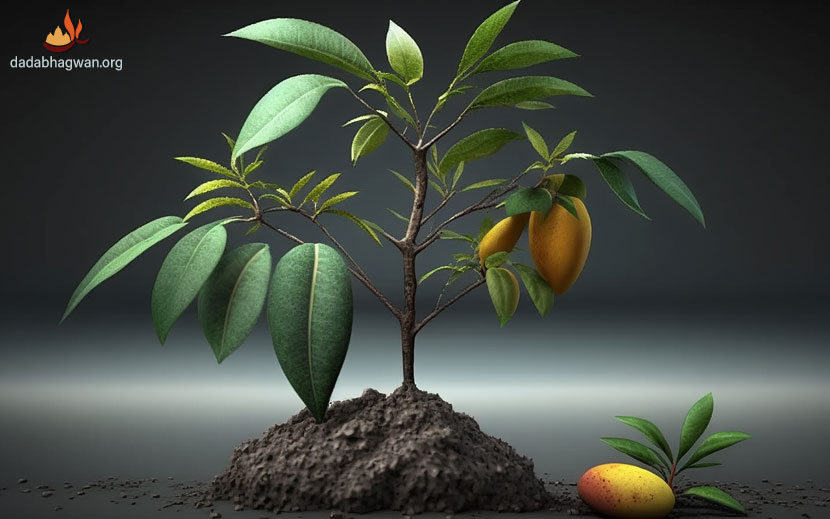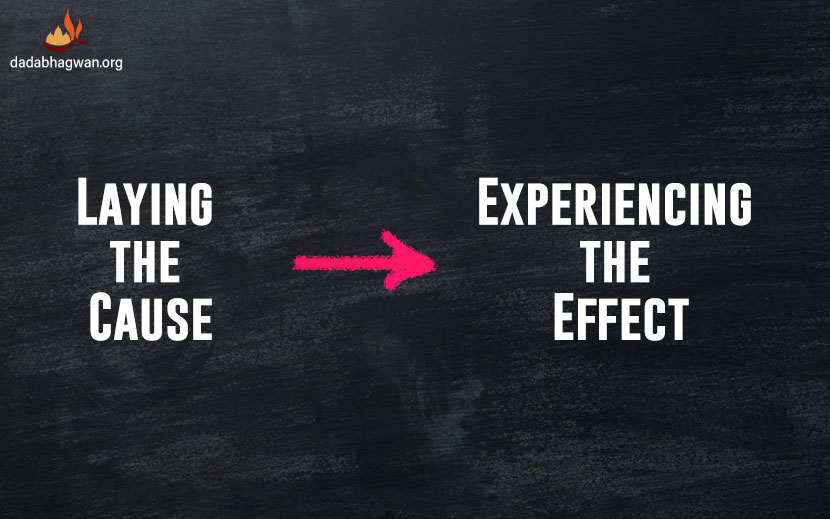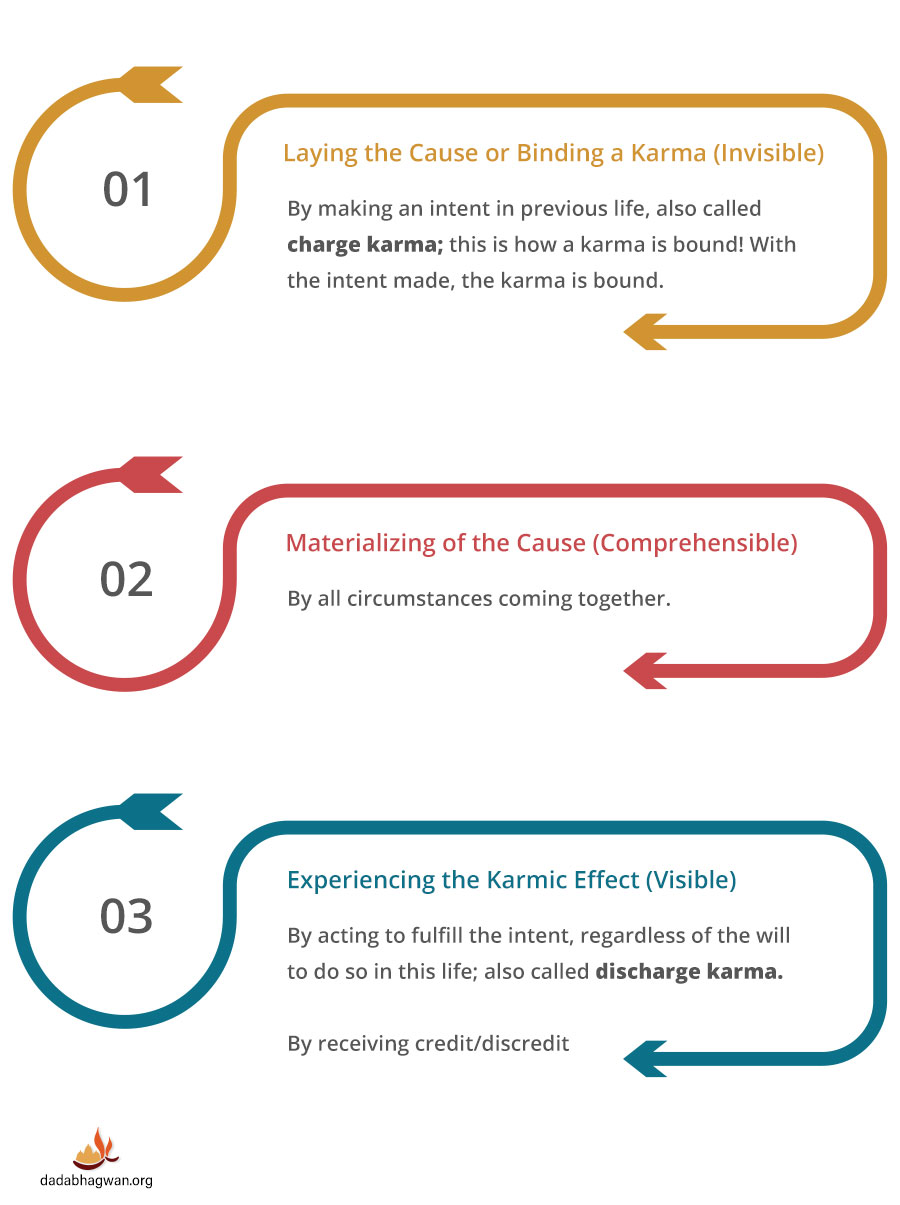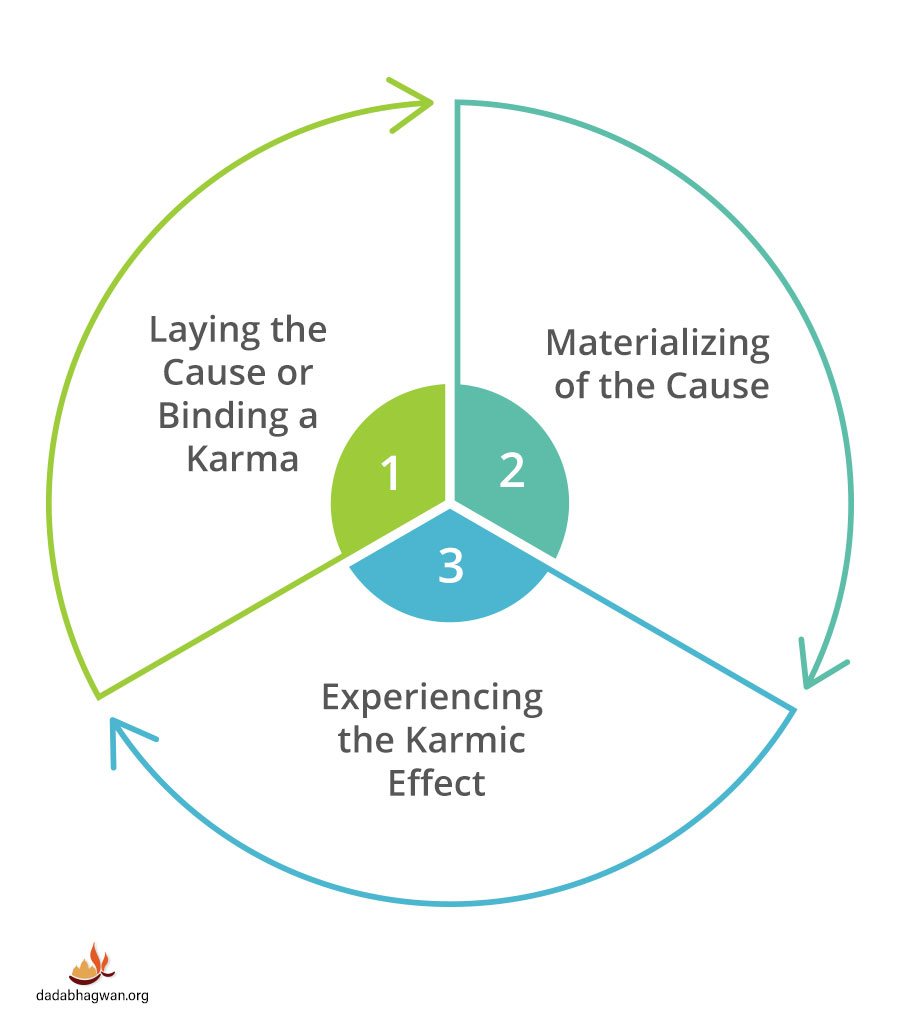How Does Karma Work: Diving Deep into the Karma Cycle
Karma works in a scientific and natural manner. Newton’s third law is the answer to how does karma work: Each action has an equal and opposite reaction. This also justifies: “What you sow, so shall you reap.”

For example, if you sow mango seeds (action), you get mangoes (equal reaction) from the seeds (opposite reaction), not apples. Here, sowing is the action, reaction is from the seeds, which is of giving mangoes (equal). In the world of humans and other living beings, a time gap occurs between sowing the seed and getting its ultimate fruit. The action of sowing seeds is laying the cause whose fruit or effect is always unavoidable or inescapable.
According to Param Pujya Dada Bhagwan, “It has to do with cause and effect—the law of karma is actually very scientific. In the physical world, it is easy to understand: you put your finger on the hot stove, it immediately hurts, right? Karma works the same way. It is the same kind of cause and effect, but because it is less tangible, it is harder to understand. There is also a time delay for the mental effects to ripen.”
So, karma works in two stages namely, cause and effect, as shown below:

Did you know that the present life of yours is nothing but the constant unfolding of the karmic seeds sown in previous life? So, what does it mean to sow the karmic seeds and how the effect is determined for humans? Let us find out!
Understanding Scientifically How Does Karma Work: Through Real-Life Scenarios
A prosperous entrepreneur donates $1,00,000 to a charitable foundation. At the time of donating money, he says in his mind, “The pressure of a reputed politician forced me to donate; otherwise, I would never donate a single penny.” For donating such a big amount and being so generous, innumerable people praise him.

On the other hand, a person who has just lost his high-paying job and had a lot of debt to clear is asked to contribute to the same institution. Nobody knows that he has lost his job. The person responds, “Sorry, I will be unable to donate now. However, if I had money, I could have given $10,00,000 without any hesitation. Right now, I just have $500 to donate.” Showing a non-generous or tightfisted response despite having a high-paying job, many people criticize him.
Observations
- The wealthy entrepreneur was able to donate money but was unwilling to do so. However, the jobless person could not although he was willing to do so!
- Both actions are against the will.
Possible Reasons or Causes Behind Donating and Not Donating
Worldly Reasons:
- The entrepreneur was able to donate because he had a lot of money. The jobless person could not donate, as he did not have money.
- The entrepreneur has bound karma by donating. For this generous act, he got the reward in the form of praises.
Questions in Mind:
- What made the entrepreneur go against the will and still donate? The politician? In that case, the praises should be for the politician, not for the entrepreneur. Again, why did this entrepreneur encounter this money demanding politician? Who brought them both together?
- Similarly, what made the jobless person go against his will of donating generously? In other words, why the chance of donating came to him when he had no money?
Understanding the Cause and Effect via Scientific Reasoning
It is essential to look beyond the worldly views to understand how karma works. According to the Indian spiritual scientist of Akram Vignan, Param Pujya Dada Bhagwan, one needs to look at the reason behind him donating money or not donating money and the reason behind how all circumstances came together for both.
Understanding What Happened in This Life
The act of donating money or not donating money is not the actual cause. It is an effect. One cannot stop an effect; one has no control over it. Coming together of circumstances and the act of donating are effects whose cause must have been laid before.
So, what is the cause? For the entrepreneur, the cause is making the intent of donating. For the other person, the cause is making the intent of not donating. Each one intended to do so in the previous life. The cause is also called charge karma. When each person’s intent (cause) materialized in this life, all circumstances came together to give the fruit against their present will or wish.
Based on this cause and effect process, the following diagram shows how does karma work:

Understanding What Will Happen in Next Life
Focusing again on the two scenarios involving a rich entrepreneur and a jobless person, it is worth noticing that they made an intent while donating or while not donating money.
Identifying the Cause, if Any
- The entrepreneur has an intent of not giving at all, which he says to himself in mind, “The pressure of a reputed politician forced me to donate; otherwise, I would never donate a single penny.”
- On the other hand, the jobless person makes an intent of giving money by saying, “Sorry, I will be unable to donate now. However, if I had money, I could have given 10,00,000 INR without any hesitation. Right now, I just have 500 INR to donate.”
Identifying the Effect
The entrepreneur has charged or bound karma for his next life in which he will be unable to donate even if he might want to. Similarly, the person without a job has also charged or bound karma for his next life in which he will be able to donate when this charged karma will come to fruition.
Even while people praise the entrepreneur for his generosity, what did he charge within? The consequence of the intent of “I would never donate a single penny” OR “I could have given 10,00,000 INR without any hesitation” will be experienced in the next life. This is the subtle karma, which is the cause of the next life’s effect.
The entrepreneur will not be able to donate any money, while the jobless person will be able to donate money in the next life. The former person has created a new life of misery for himself for the causes, which exist within him and will go with him in his next human birth. The donation made or not made in this life was an effect.
Breaking the Myth:
Donations, charitable deeds, and so on are all visible karma, also known as discharge karma, the benefits of which are reaped in this life. People believe that these visible karmas are the charge karmas for the next life. In fact, it is the subtle karma, happening within, that is a charge karma or subtle karma, which will come to fruition in the next life. So, during each visible karma or effect, subtle karmas are charged, which are then discharged in the next life.
According to Param Pujya Dada Bhagwan, “Effect can never be removed. Effect means result. The result cannot be pushed aside, but the causes can be stopped. The effect is a discharge and the causes, the charging, take place within as one is undergoing the effects. The charging, the cause, can be stopped but we cannot stop the discharge, the effect.
The Ultimate Principle of How Does Karma Work
In the given scenarios, both laid the cause of the next life while experiencing the effect in this life. This means karma works in a cyclic manner. During an effect, the cause is laid; and the cause certainly gives its effect. This forms the karma cycle.

This cycle explains how bad karma works and how good karma works. If the cause was good (good intention), the effect is pleasant. Similarly, if the cause was bad, the effect is unpleasant.
Param Pujya Dada Bhagwan has spoken in detail in spiritual discourses about this karma cycle and how it forms the basis of reincarnation. Here is a part of that discussion:
Dadashri: While undergoing the effect of past karma, causes for new karma are created simultaneously. These causes then become ‘effective’ as thoughts, speech, and acts in the next life. This is how the cycle of cause and effect, effect and cause, continues. Only in the human life form is it possible to create causes. In the rest of the life forms (animal kingdom, hell, celestial), there is only effect. Here, in the human life form, we have both causes as well as effects. When ‘we’ give you Gnan, ‘we’ stop the causes. Then there will be no new effects.
Questioner: Does karma apply to human beings?
Dadashri: Human beings do nothing but bind karma, constantly. The human ego is such that even though it does not eat, drink, or conduct any actions in the worldly life, it still maintains a notion of doership, which is why it binds karma. Karma is bound through the ego that says, "I am doing it." Is it not a wonder that happens? It can be proven that the ego does not eat, drink, or do anything else. It can also be proven that despite not doing anything, it binds karmas. Only humans bind karmas.
One cannot see karma being bound. People in general think of karma as something that is visible to the eye. They may see someone hurt another person and assume that, that is how the person charges karma. Is that not what people believe?
Questioner: Yes, they say it as they see it.
Dadashri: People believe that karma is the external activities people do like eating, sleeping, hitting someone etc. People label all actions as karma. But, in reality, the activity they see is really the fruit of karma and not the actual karma itself. Whenever karma is bound, there is internal suffering. What does a child do when you give him bitter medicine? He makes a face! When you give him medicine that is sweet, he will like it. When people do raag-dwesh (attachment-abhorrence), they are planting causes that give rise to new karma. You will have to experience karma that you like and also the ones you dislike. The ones you do not like will leave you hurting while those you like will leave you happy. The causes that were created in your past life bring fruits to you, in this life.
When you have no abhorrence towards the one who curses you, and no attachment towards the one who garlands you and takes care of you, then karma will not bind. Raag is attachment. Dwesh is abhorrence.
The body has come about as a result of ignorance of the Self. It is the effect of all the causes you created. The mind, speech and body are all effective. While experiencing the effects, one creates new causes. The cycle of cause and effect is perpetuated in this manner. Even the foreign scientists can understand the concept of reincarnation in this way!
Thus, karma and reincarnation are related! The karma cycle explains how does karma impact your next life.
Summary
There are just three steps to understand how does karma work for each human being namely, laying the cause, coming together of circumstances for giving the effect of the cause, and experiencing the effects. What people call karma is truly an effect. Its cause was laid in the past life by making an intent. When the intent was made, the karma was bound or charged. This act of binding karma is not visible. What is visible is the effect of karma, right from donation to praises in the example covered in this post, which materializes after a significant amount of time.
subscribe your email for our latest news and events





